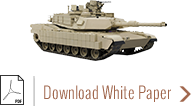Battery Monitoring Military Applications
Merlin Power Systems is providing energy storage, battery monitoring, power generation, and power management solutions to the US military. This white paper introduces battery monitoring and explains how Merlin’s battery monitoring solutions are helping the US military.

Battery Monitoring Basics
The purpose of battery monitoring is to obtain accurate State of Charge (SoC is a percentage of battery capacity remaining) and State of Health (SoH is the capacity of the battery as a percent of its original capacity) readings. SoC is often thought of as the equivalent of a fuel gauge for a battery bank; in this analogy, SoH would be the size of the gas tank.
Discharging a lead-acid battery to less than half of its capacity is not recommended because it begins to cause internal damage to the battery. Ideally, a 100 Ah battery should not be discharged below 50Ah. For this battery Merlin defines 50Ah remaining as 0% SoC; 100Ah remaining is 100% SoC so for example 75Ah remaining would be 50% SoC. The capacity of the 100Ah battery in our example may decrease to 90Ah after regular use. SoH is the measure of the capacity decrease and the battery is said to be at 90% SoH.
Trouble Abroad and Trouble Onboard
The US military’s ground and maritime mobility platforms in Iraq and Afghanistan have experienced significant problems generating and distributing enough power for on-board systems. The original design of electrical systems did not account for the power storage, generation, monitoring, and management required to operate electronic counter measures, communications, computers and displays, sensors, remote weapon systems, and other electronics. The consequences of inadequate electrical systems for today’s warfighter manifest themselves in many ways including economic costs, decreased capability, and ultimately lives put at risk.
Massive costs are incurred to supply the US military with batteries and fuel. Inadequate power management such as excessive discharge, improper charging, and inadvertent abuse leads to premature battery failure. Vehicles typically carry 2 to 8 batteries which can cost $4,000 each when logistical costs are accounted for. Due to lack of confidence in power availability, crews continuously idle their engines to ensure battery banks are charged. Pentagon officials have told the House Appropriations Defense Subcommittee a gallon of fuel costs about $400 by the time it arrives in remote regions of Afghanistan. Well over half of U.S. military casualties in Afghanistan are due to improvised explosive devices; many of these devices are placed in the path of supply convoys carrying fuel1.
The Battery Monitoring Challenge

Traditional battery monitoring methods fall into four categories: measuring voltage, impedance measurements, amp hour counting, and battery modeling. Voltage measurement is a poor technique for measuring SoC because it is inaccurate when the battery is being charged or discharged. Impedance measurement techniques consume too much power to be applicable for monitoring. Amp hour counting measures SoC by tracking the energy entering and leaving the battery. Amp hour counting is accurate, but becomes less and less accurate over time. After only a few battery cycles, amp hour counters must be reset (batteries are fully charged and SoC is set to 100%). Battery model based monitors can estimate SoC without synchronization. However, they do not estimate SoH and are not as accurate in the middle of the charge cycle where amp hour counters excel.
Knowledge is Power

DataCell II combines the accuracy of amp hour counting and a proprietary battery model that never needs synchronization. Neither amp hour counters nor model based monitors can calculate SoH in isolation. When combined, their accuracy is so great that DataCell II provides SoC within 2% and SoH within 1%.
With accurate information, military personnel can make informed decisions. Confident in the level of power available to them (SoC), military personnel can conserve fuel by eliminating inefficient engine idling. Confident in the condition of vehicle batteries (SoH), crews no longer need be tempted to prematurely swap out healthy batteries. Furthermore, DataCell II can inform Merlin’s power management solutions for automatic coordination of power generators (such as the vehicle alternator), power consumers (on board electronics), and power storage (battery banks). The power management approach ensures battery health and maximum efficiency.
1. According to http://thehill.com/homenews/administration/63407-400gallon-gas-another-cost-of-war-in-afghanistan-.

